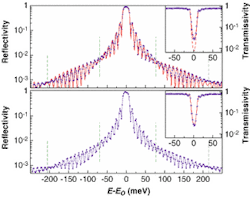Physicists demonstrate first x-ray Fabry-Perot interferometer

After many years of preliminary studies, researchers have announced the first demonstration of a Fabry-Perot (FP) interferometer for hard x-rays. Visible-wavelength FPs have been used for more than 100 years in the physical and life sciences but x-ray wavelengths have proven to be a challenge, mostly because x-rays do not reflect from surfaces as easily as do visible wavelengths.
Fabry-Perot interferometers (resonators) can be used to measure wavelengths at high resolutions in atomic spectroscopy, astrophysics, and laser physics, even in the infrared. An x-ray FP interferometer could be used for phase-contrast imaging of nanometer-scale objects, for studying dynamics of solids, liquids, and as interference filters with microelectronvolt spectral resolution. The advance also paves the way for novel x-ray optical devices
Until now, back-reflection mirrors with high enough reflectivity to cause interference at x-ray wavelengths had not been successful. Yuri Shvyd'ko and colleagues at the University of Hamburg (Hamburg, Germany) and the Argonne National Laboratory (Argonne, IL) used two back-reflecting sapphire crystal mirrors to solve this problem.
In the prototype x-ray FP interferometer, 14.315-keV x-rays were reflected backwards via (0 0 0 30) Bragg reflection in two single sapphire (α-Al2O3) crystals placed 53.7 mm apart. Backscattering caused the x-rays to bounce back and forth between the two parallel mirrors, causing an interference pattern with sharp FP resonances. The x-rays were constrained in a bandwidth of 2 meV and had a beam divergence of 15 × 40 µrad. The time response of the interferometer measured a finesse of 15- and 0.76-µeV-wide FP transmission resonances—a spectral resolution 100 times better than existing x-ray crystal monochromators. Because x-ray monochromators cannot resolve the narrow peaks, the energy resonances were detected in the time response of the FP by an x-ray detector with 120-ps time resolution.
Because the sapphire crystals are transparent at visible wavelengths, the researchers point out that a combined optical/x-ray interferometer may be realized by coating the sapphire x-ray mirrors to make optical mirrors. Such combined optical/x-ray FPs could be used to directly measure x-ray-to-visible wavelength ratios.
REFERENCE
- Y. V. Shvyd'ko et al., Phys. Rev. Lett. 90, 013904 (2003).
About the Author
Valerie Coffey-Rosich
Contributing Editor
Valerie Coffey-Rosich is a freelance science and technology writer and editor and a contributing editor for Laser Focus World; she previously served as an Associate Technical Editor (2000-2003) and a Senior Technical Editor (2007-2008) for Laser Focus World.
Valerie holds a BS in physics from the University of Nevada, Reno, and an MA in astronomy from Boston University. She specializes in editing and writing about optics, photonics, astronomy, and physics in academic, reference, and business-to-business publications. In addition to Laser Focus World, her work has appeared online and in print for clients such as the American Institute of Physics, American Heritage Dictionary, BioPhotonics, Encyclopedia Britannica, EuroPhotonics, the Optical Society of America, Photonics Focus, Photonics Spectra, Sky & Telescope, and many others. She is based in Palm Springs, California.
